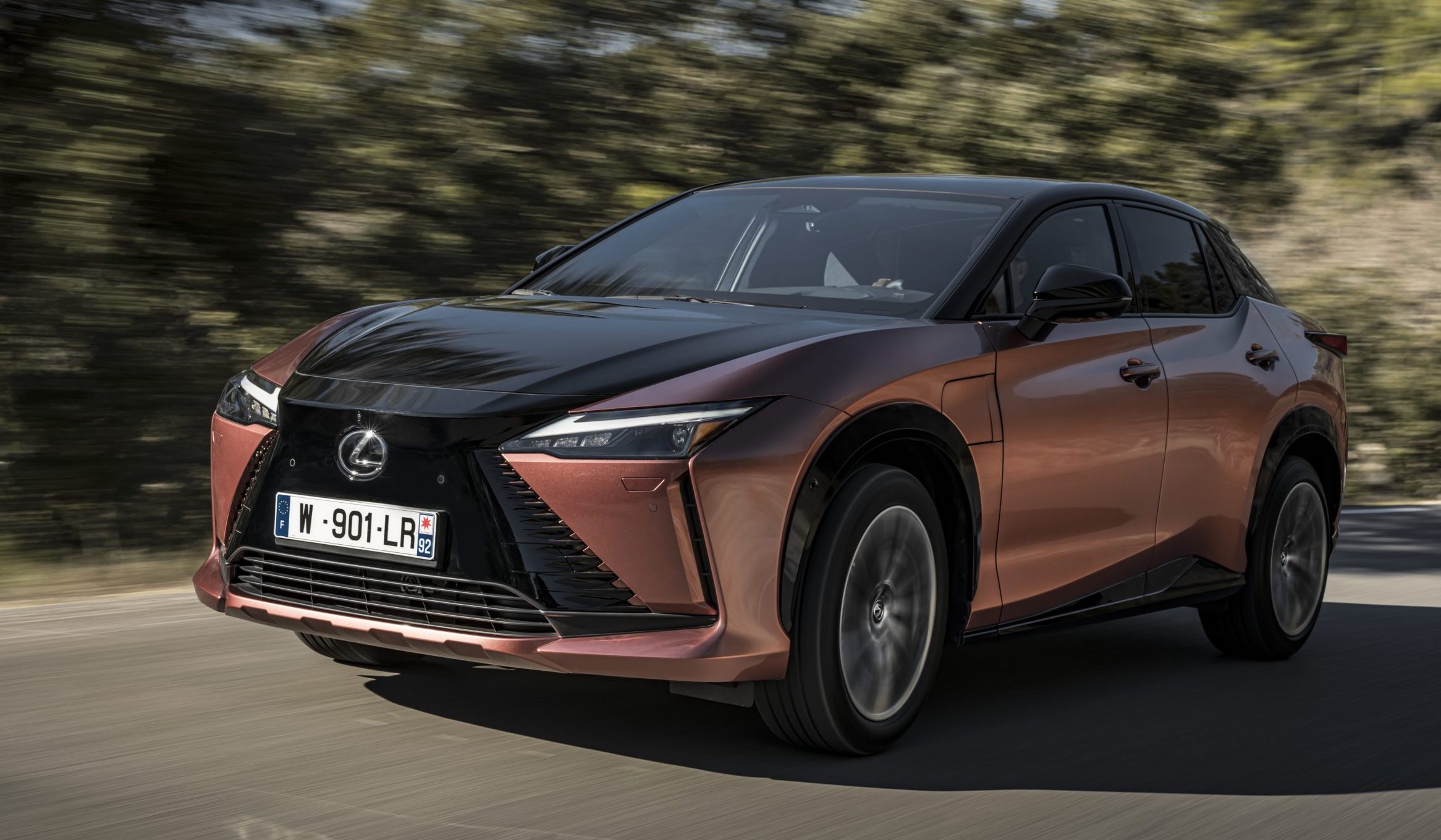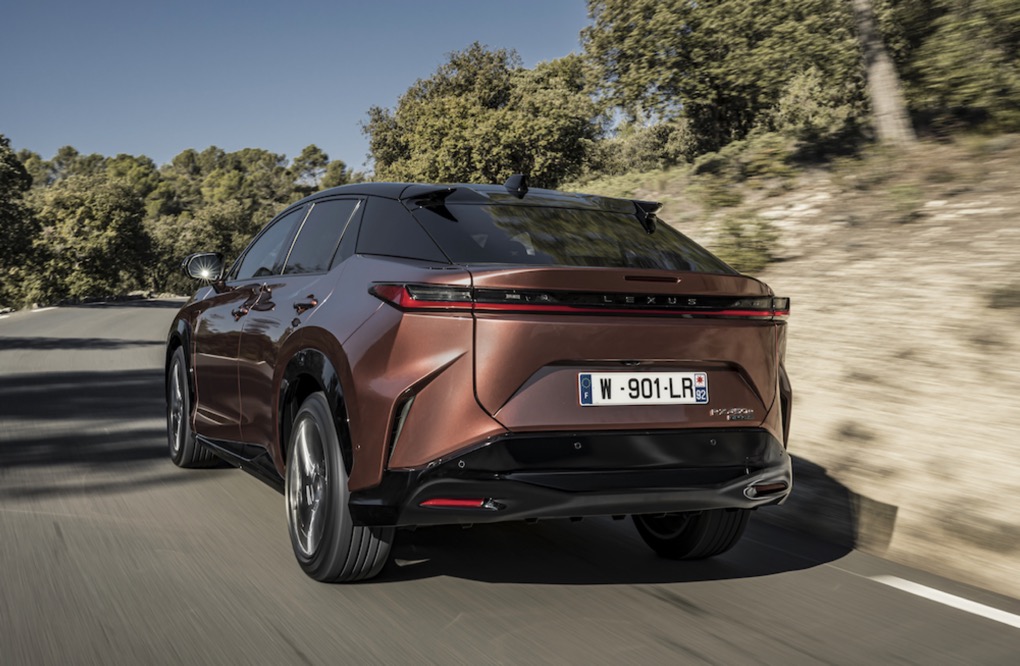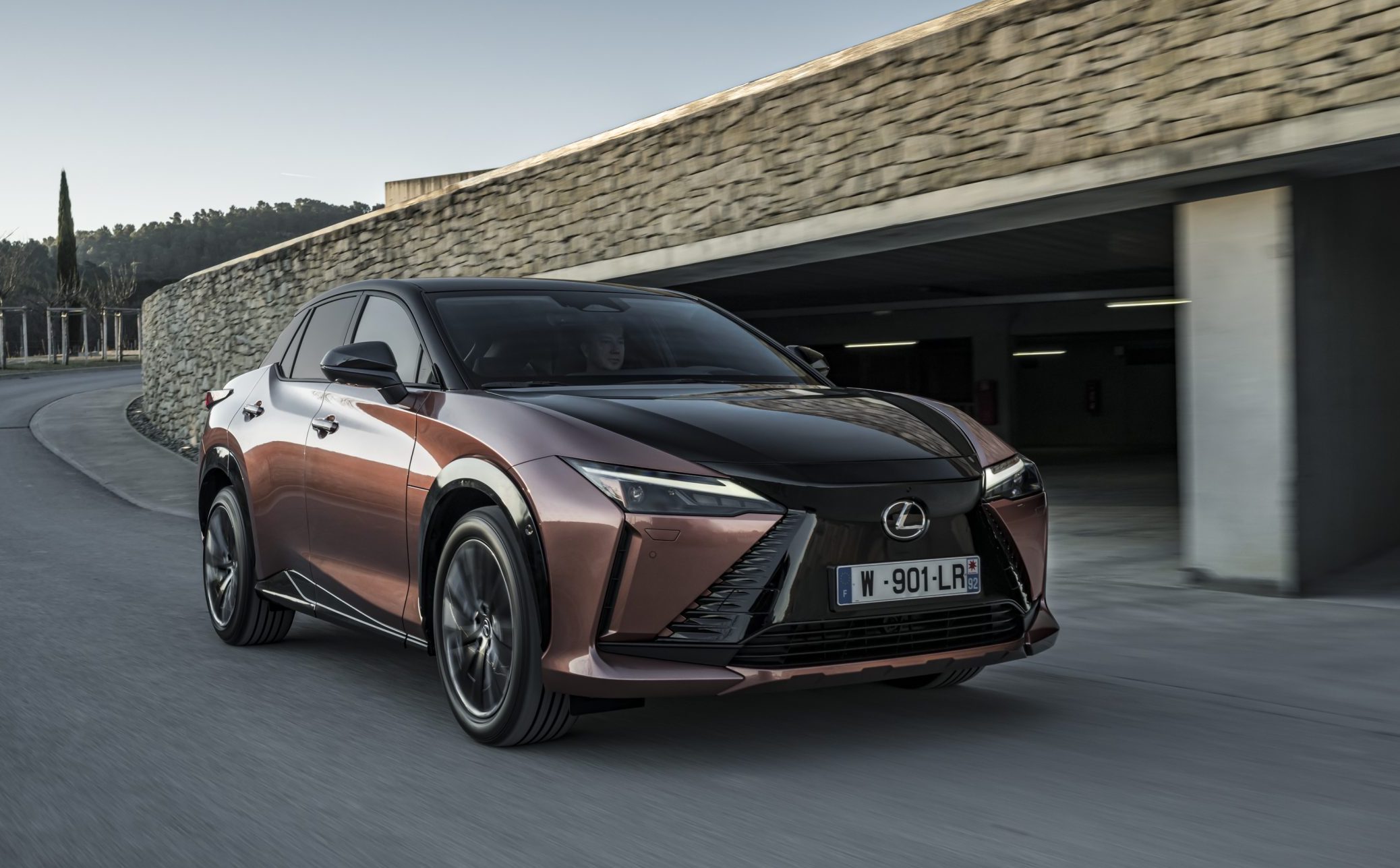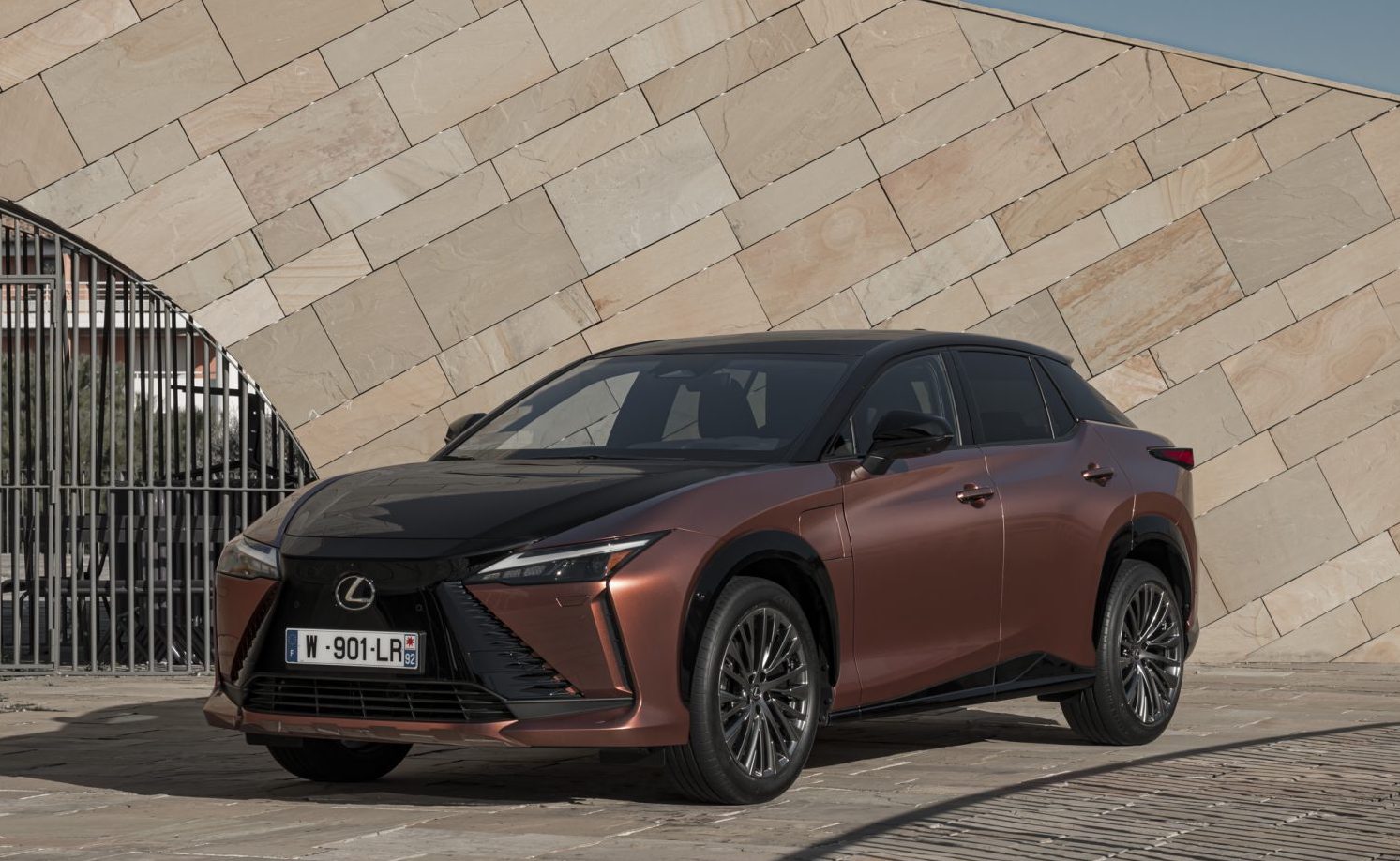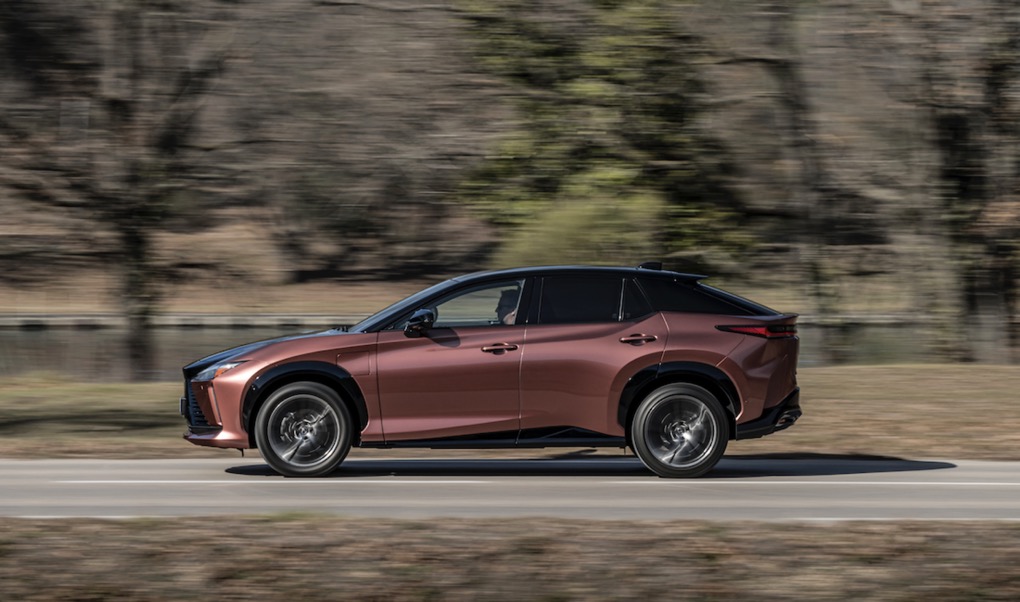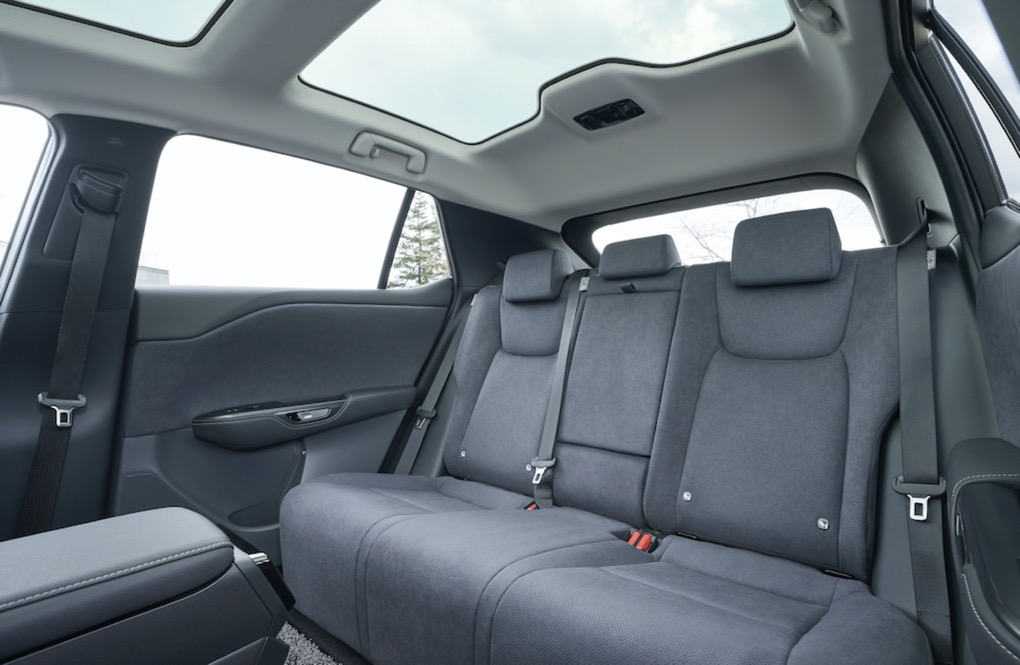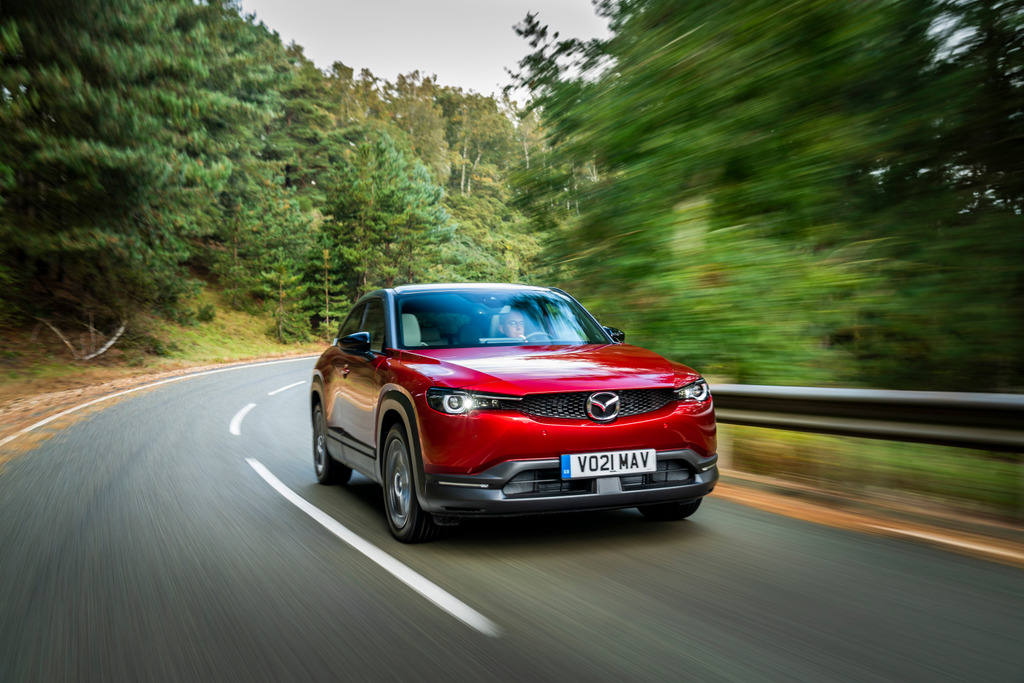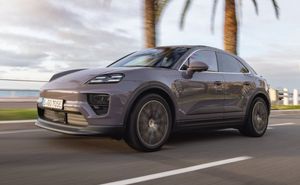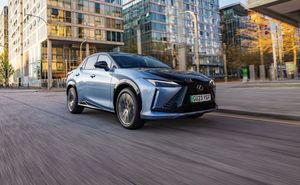Consequently, there is a lot of tech talk in this review. If you just want all the normal review topics such as charging times and boot space, skim through to the middle.
Lexus RZ450e One Motion Grip
We’re starting with this as it is the most spectacular of the Lexus’ technology. The RZ doesn’t have a component which has been considered essential since the invention of the car – a steering column. There is no mechanical connection at all between the driver and the wheels. This is the first car to have that.
Lexus calls it One Motion Grip, or (appropriately) OMG for short. It’s going to be available as an option from 2025, so there is still a wait before you can get your hands on it. The cost is not yet known either.
The tech raises a lot of questions, so let’s deal first with how it works. On cars fitted with OMG, the traditional round steering wheel is replaced with a yoke, like you’d find in an aeroplane cockpit.
Tesla had a yoke on the new Model S and X, but that was just a conventional steering system with a funky steering wheel. This means it has drawbacks and owners have found it tricky to use.
In the RZ, the yoke is connected to sensors and a motor, which then tell another motor down by the wheels what to do via a wire.
The clever part is that the ratio of movement can change depending on the situation. If you are pulling out of a parking space, it takes just a quarter turn to get full lock. Turning from full lock left to all the way right is just 150 degrees, so there is never a need to cross over your arms or shuffle the steering wheel through your hands.
However, when you have gained speed it feels more like conventional steering with much bigger movements needed. It takes a few minutes to get used to this and requires a little calibration at first, but it soon feels natural.
One of the interesting parts of the technology is that there is still ‘feel’ through the steering. You can tell when there is a change of road surface, or you go over a cat’s eye.
It will also go light if you start to slip, just as with a conventional steering system. But all of that feedback is artificial. It is sensed by the monitors down at the wheels and then recreated by the module attached to the yoke – just like in a sophisticated computer racing game.
But one of the reasons Lexus has created this system is because it can filter what you feel. The ‘desirable’ feedback makes it to your fingertips. Anything considered unpleasant gets removed. This makes the RZ very refined without feeling remote.
For the first few journeys you might find yourself making little corrections because you’ve turned a little too much at a roundabout, and it did occasionally feel like it was getting momentarily confused in tight corners at speed, but it’s never dangerous.
The feedback level can be tuned too. In the RZ’s ‘Sport’ mode it has more feedback, but in future Lexus’ engineers say they can modify the steering to suit a sportscar or big luxury limo. The RZ is roughly half way between those two, with some feedback but not so much it feels like a race car.
The system will also sense if the car is being pulled off the intended line by something like a camber in the road and automatically correct it, so you won’t have to constantly pull on the yoke to keep an intended line.
Another advantage of the yoke is that you can see all of the instruments clearly, which isn’t the case with the conventionally-steered version, where much of the screen is obscured. Most of the crucial statistics are displayed on a head-up display, but it is still an irritating oversight.
Unlike Tesla’s yoke, the Lexus has a proper stalk to operate the indicators and wipers. It’s slightly odd because it rotates as you turn, so it sometimes isn’t where you expect it to be. But you do get used to it as your hands are always in the same place and not shuffling around.
The bigger question is around safety, and if the OMG system will cause you to test the RZ’s nine airbags. Lexus’ engineers point out that fighter and passenger planes have used fly-by-wire systems for years, and these work in the same way.So like an Airbus, there are back up systems so if one motor fails or the power is interrupted, another motor and a separate battery takes over.
This is partially why the OMG is more expensive to buy, (no prices have been announced yet, but expect an extra £30 on a monthly payment), about 10kg heavier and actually uses a bit more energy than a conventional steering system. This isn’t a compelling argument. But it’s nicer to drive, there’s no doubt. And gadget lovers will adore it enough to pay the extra few quid on the finance.
The bigger story will come when cars are designed to have something like OMG from the start. That will mean a lot less engineering for the swap from left or right hand drive, better packaging and crash test performance too. It will also integrate seamlessly with autonomous driving systems. The engineers reckon it will be on pretty much all new cars in a decade’s time for those reasons.
Lexus RZ450e Radient Heaters
If that’s not too much tech for you, let’s steer away to another clever innovation which has a direct benefit for electric car drivers because it saves a lot of energy.
The Lexus has radiant heaters, a bit like those ones you see outside pubs and restaurants to keep people warm while they feed their nicotine addictions. Rather than blasting out heat, they radiate infra-red waves, which warm surfaces rather than the air in the car.
On the RZ they are in panels hidden on the lower half of the dashboard beneath the steering column and facia. They don’t glow red, and most times you can’t feel they are working at all because in auto mode the system just works out exactly what you need on both the radiant and seat and steering wheel heaters.
If you want to feel it though, you can turn them up manually and feel like you are in front of a warm fire. Unlike a bonfire though, there is no danger of getting scorched if you get too close as the panels sense if something touches them and reduce the heat.
Because warming the person rather than the car is more efficient, Lexus boffins say energy consumption is reduced by around eight per cent compared to standard climate control, which is worth a few miles extra range on a cold day. The driver’s panel consumes just 70w, which is less than an old-fashioned lightbulb.
Lexus RZ450e battery, range and charging
The RZ has the same battery as the Toyota bZ4X, with a capacity of 71.4kWh, of which 64kWh is usable. But it has a more powerful combination of motors, which means the range is smaller than the Toyota’s, at between 245 and 270 miles. Those figures are also slightly lower than rivals such as the new Audi Q8 E-tron and BMW iX3, but the RZ’s efficiency matches or beats them – at least in the lab.
The smaller 245 mile figure is for RZs fitted with the bigger 20-inch wheels as they cause more drag. Bear that in mind when ordering as it’s a huge difference and you’d feel pretty silly if you ran out of charge 25 miles from home for the sake of fashion.
Lexus has taken measures to make sure the RZ isn’t affected by some of the range issues which have blighted early versions of the Toyota too, including new software to open up more of the ‘safety buffer’ in the battery.
Toyota’s engineers had been a bit paranoid about leaving driver stranded, so the bZ4x had around 30 miles of ‘reserve’ left even when the range meter said zero. That panicked owners who thought zero meant zero, so on the Lexus the buffer is reduced to 15 miles to give a more realistic view of if you’ll make it home.
If you are still getting anxious, the RZ features a fourth setting in the drive modes called ‘Range’ which restricts the performance by switching off the front motor and killing the air conditioning to maximise efficiency.
When the battery is empty, you can charge at up to 150kW at a suitable DC rapid charger, which is on the low side these days. It means a top up from zero to 80% takes about half an hour.
Lexus RZ450e performance and driving
The RZ uses the front motor from the two-wheel-drive Toyota bZ4x and the same rear motor as the 4WD version. This gives more power - they produce a total of 313 hp, but the front produces 204 of them. That’s unusual for a luxury car like this, which would usually have more power at the rear or an equally matched pair.
This doesn’t mean the Lexus feels unruly though, as the combination of the computer controls and the steering mean it always feels composed, even if you plant the throttle.
If you are not too worried about range, then the Lexus is more than fast enough. Its 0-62 acceleration time of 5.6 seconds is as much as you’d every need in the real world and comparable to the usual rivals from Germany, but notably below the Jaguar I-Pace and Tesla Model Y.
We tried both the lower spec car with 18-inch wheels and standard steering, and the posher Takumi version with the OMG and 20s. As you’d expect, the car on 18s is more refined but the difference isn’t as marked because the clever steering filters out some of the harshness you’d usually feel through the wheels. Generally, this is a very relaxing car to drive. It can go fast, but it’s not something it encourages you to do. The RZ is just refined and smooth.
The brakes are strong too, and there is variable regen which can be altered using paddles behind the steering wheel. In max mode, it’s almost a ‘one-pedal’ car if you want it to be.
The only real issue is wind noise, which is undoubtably more pronounced as the rest of the car is so refined. We think is due to the oddly large door mirrors. The cameras used by some rivals are an acquired taste which we have yet to acquire, but since Lexus offers them on its other models its strange they’re not on the high-tech RZ, where they would improve refinement and reduce aerodynamic drag.
Lexus RZ450e Interior, space, tech and practicality
First, let us put the RZ’s size in context, as it’s easy to get confused with the Lexus models as they look similar and have two-letter names. The RZ is 4.8 metres long – that’s longer than a Tesla Model Y. That means it sits between the mid-size NX and largest RX SUV models in the Lexus line up.
The one dimension which isn’t big is the height. At 1.6m it is the same as a Nissan Qashqai which means you might be a bit disappointed if you like the taller driving position of an SUV.
Inside, the dashboard and seats are obviously a bit more premium than the Toyota, which one of the team described as being ‘like something from a van’.There’s all the usual tech you’d expect and a nice balance of physical and touchscreen buttons. Even on the screen, the important ones are always there so you don’t have to go through menus to find the heating.
There are quite a few buttons which are on the yoke or steering wheel, but they are intuitive to use and you can set the functions to do what you want them to. There’s also a Mark Levinson Premium Surround Sound system on the top model which is designed especially for this car. Mark Levinson seems to know his stuff, because it sounds great.
In the back there is a reasonable amount of space for three passengers, and the boot measures out at 522 litres with the seats up – that’s slightly bigger than a BMW iX3 and smaller than an Audi Q8 e-tron. Under the floor is a sizeable, wipe clean stash for cables and mucky stuff like wellies. There’s no rear wiper though, which we know is one of readers’ pet hates.
Lexus RZ450e pricing and verdict
The pricing is a bit of a blackfly in the Lexus’ chardonnay. When the RZ arrives in the UK in early summer 2023, the cheapest will cost £62,600 and the most expensive will be £72,100. We all seem to use Tesla as a benchmark, and currently £60,000 will buy you a Model Y Performance, which is faster and more spacious. It can’t get close to the RZ’s build quality though.
The newly revamped Audi Q8 e-tron starts at £68,595, and the top versions of the Lexus are overlapping with the Jaguar I-Pace. We all have a tendency to forget that car because it’s been around for so long, but it can still hold its own against the best.
In its defence, the Lexus has a 10-year 100,000 mile warranty and the brand’s traditionally strong resale values mean the monthly payments should be reasonable. It’s likely to cost less per month on a lease or PCP than the Model Y, for example, even though that car is cheaper.
On paper, the Lexus doesn’t seem to do much better than any other rival, except for all that clever tech which you can show off.
But there is something very calming and about driving it. It refined, beautifully made and nicely designed. The door shuts with a ‘thunk’ which is deeply satisfying and you know it will keep on working like that for years. The dealer will also have nice coffee and know your name when it’s time for a service. For you, that might be worth more than a three second 0-60 time or built-in whoopee cushion.





.png)





